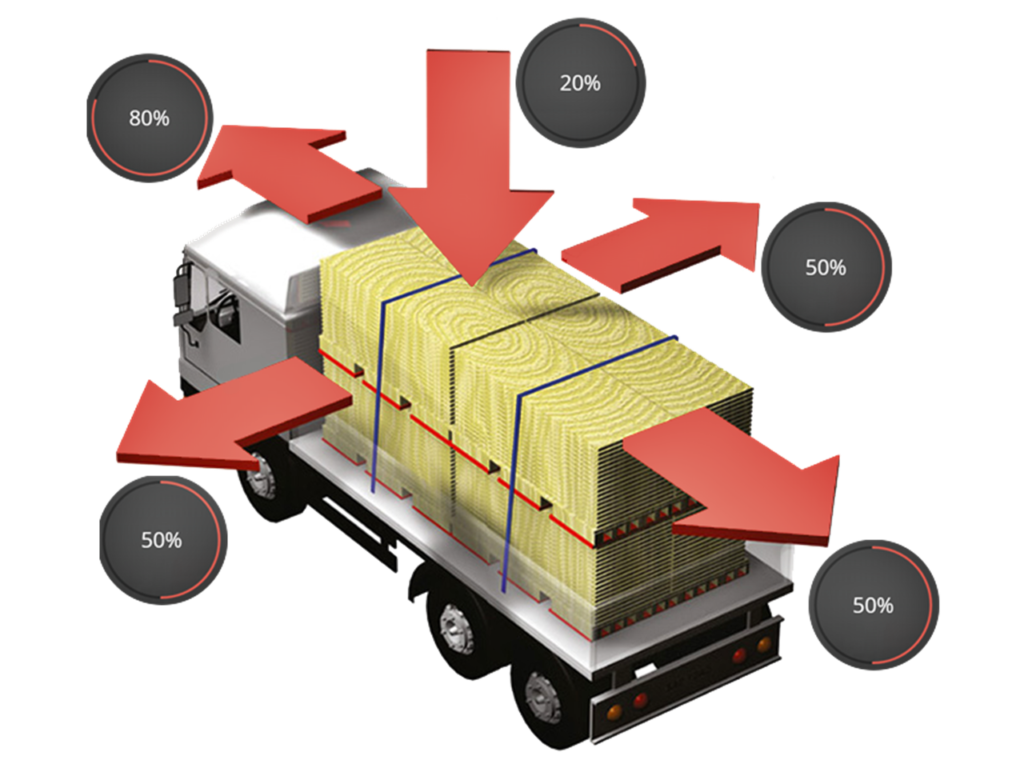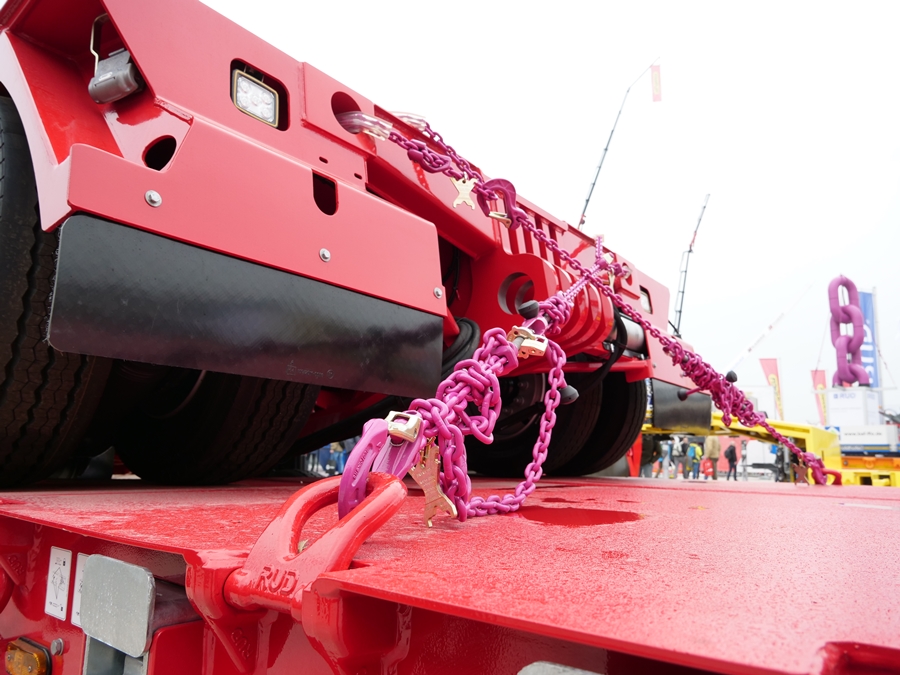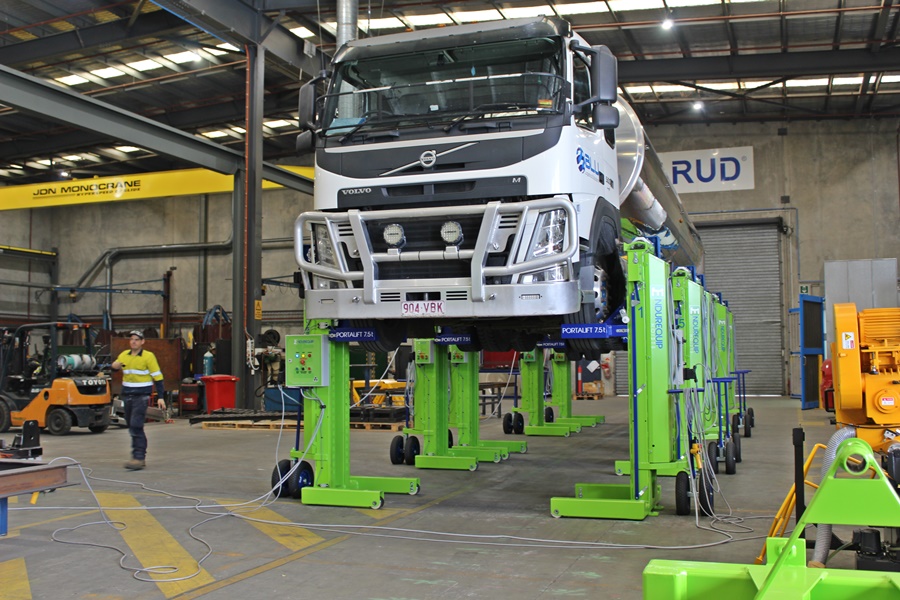When transporting heavy machinery and cargo, secure and reliable lashing points are critical. These critical components not only guarantee the safety of goods during transit but also minimise potential damage and costs. In addition, appropriately secured loads significantly reduce the risk of accidents caused by shifting cargo, protecting drivers, passengers, and other road users*.
* If you want more details on the importance of load securing, including the NHVR Load Restraint Guide, read our 2-part article published earlier:
The Importance of Secure Lashing During Transport
Imagine a scenario where a load shifts unexpectedly during transport in your heavy vehicle. Not only could it damage the cargo itself, but it also poses a significant risk of accidents for drivers, passengers, and other road users. This is why proper load restraint using certified lashing equipment, as mandated by the Australian Load Restraint Guide, is absolutely crucial.

RUD: A Global Leader in Lashing Solutions
RUD is a world leader in the lifting and lashing industry and offers a comprehensive selection of lashing points with capacities ranging from 3,000 to 32,000 daN. These lashing solutions cater to diverse sectors, including the lashing of heavy and large loads in cargo transportation, vehicle transport, railway operations, and construction equipment.
Uncompromising Quality and Compliance
RUD takes quality and compliance seriously. All the RUD lashing points undergo rigorous 100% crack testing and adhere to the strictest quality control procedures. This ensures that you receive reliable and compliant products that meet the demands of heavy vehicle transport.
Flexibility and Adaptability for Optimised Loading and Unloading
When it comes to efficiency, RUD's lashing points are designed for unmatched flexibility during loading and unloading operations. The compact designs with large eye diameters allow greater versatility when using different lashing equipment. The diverse welding surfaces also enable easy and seamless integration into the truck or trailer chassis during the build process.
For instance, the RUD OPTILASH-CLICK system stands out for its ability to be moved along the chassis, reducing the required number of lashing points. This translates to cost savings and a lighter weight for your heavy vehicle.

Benefits of Choosing RUD Lashing Points
There are numerous advantages to incorporating RUD lashing points into your transport operations:
Without Trucks, Australia Stops! But when trucks need to go, Endurequip keeps them going!
To be continued ...
Article copyright to RUD Group. This information is accurate at the time of publication, and RUD Australia takes no responsibility for any errors, inadvertent or otherwise.
Welcome aboard Australia’s leading material lifting and handling technology company.
Click below to read about us, our products, news, blog posts and everything happening at RUD in Australia and around the world.
Tradition in Dynamic Innovation.
The transition to electric vehicles (EVs) is rapidly transforming the transportation landscape, and the impact extends beyond passenger cars. Heavy-duty vehicles like trucks and buses are also going electric, bringing significant changes to the way they are maintained and repaired.
Electric Vehicles are also changing the revenue stream of workshops with fewer oil changes and seasonal inspections. In addition, EVs can be heavier than their diesel counterparts because of the significant weight of the battery, resulting in higher tyre wear rates. Electric Vehicles (EVs) can wear out tyres up to 30% faster than traditional diesel vehicles, making the need for tyre replacements more frequent.
This article explores how electric trucks and buses will change the operations of mechanical trucks and bus workshops. It also focuses on the challenges and opportunities presented by the unique undercarriage design and the adaptation required to lift these heavy vehicles.
A New Era of Service:
The transition to electric vehicles requires mechanical workshops to adapt their skillsets and equipment to cater to this new technology. Governments and councils across Australia are offering courses and support to mechanics to transition to electric vehicles. NSW is planning to phase out diesel buses by 2030, while the ACT Government procured the first zero-emission buses last year. Brisbane Council is working with the Queensland Government to introduce their Zero Emission Vehicle Strategy by introducing zero-emission buses starting in 2025.
While the core principles of mechanical maintenance remain the same, electric trucks and buses introduce distinct elements that necessitate adjustments in workshop operations.
High-voltage systems: Servicing electric vehicles necessitates specialised training and safety protocols to handle high-voltage (HV) batteries and electric motors. Technicians must be certified and equipped with appropriate compliance requirements to work safely with these components.
Diagnostic Tools:
Traditional diagnostic tools used on internal combustion engine vehicles are not suitable for EVs. Workshops need to invest in specialised diagnostic equipment and software specifically designed for electric powertrains.
Focus on Preventative Maintenance:
Unlike internal combustion engine vehicles with regular component wear and tear, electric vehicles experience less frequent mechanical issues. However, preventative maintenance becomes crucial to ensure optimal battery health and performance. Workshops will need to develop specialised service packages and schedules tailored to electric vehicles.
The Undercarriage Challenge: Mobile Column Hoists and Electric Vehicles
One of the most significant challenges posed by electric trucks and buses lies in their undercarriage design. Unlike traditional vehicles with engines and fuel tanks located beneath the driver's cabin, electric vehicles house their battery packs under the vehicle floor, impacting the feasibility of using lifting equipment with tyres. This is particularly relevant to mobile column lifts, which need to be modified with adaptors to be used with both electrical and diesel engine vehicles.
Some of the Challenges for Mobile Column Lifts are:
Limited access points: The placement of battery packs underneath the chassis can restrict access to the tyres with mobile column hoists. This requires a careful selection of lifting points to ensure safe and stable lifting without compromising the integrity of the battery pack or other vital components.
Weight distribution: The weight distribution of electric vehicles differs from diesel vehicles due to the placement of heavy batteries. Workshops need to ensure the hoist configuration can handle the specific weight distribution of the electric vehicle being serviced, maintaining proper stability during the lifting process.
Lifting point adaptors: Depending on the specific vehicle model and lift design, workshops might need to invest in specialised lifting point adaptors to ensure proper contact and distribution of lifting force while avoiding damage to the undercarriage or battery pack.
Embracing the Change: Opportunities for Workshops:
Despite the challenges, the transition to electric vehicles also presents opportunities for workshops to adapt and thrive:
Invest in specialised tools and equipment: Workshops can invest in specific tools and equipment designed for servicing electric vehicles, such as high-voltage diagnostic tools, battery management systems, and lifting adaptors. This allows them to offer comprehensive services for the growing electric vehicle fleet.
Develop new service packages: By offering specialised preventative maintenance and repair services tailored to electric vehicles, workshops can attract new customers and differentiate themselves from competitors.
Upskill workforce: Training existing technicians and recruiting personnel with expertise in electric vehicle technology is crucial to ensure a skilled workforce capable of servicing these vehicles safely and efficiently.
Conclusion:
The transition to electric trucks and buses requires significant adjustments from mechanical truck and bus workshops. While mobile column hoists face challenges due to the different undercarriage designs of electric vehicles, proactive workshops can adapt by investing in specialised tools, developing new service offerings, and upskilling their workforce. By embracing the change and staying at the forefront of technological advancements, workshops can ensure they are well-positioned to thrive in the evolving transportation landscape.
Without Trucks, Australia Stops! But when trucks need to go, Endurequip keeps them going!
If you want to know how the team at RUD can help you, please call 07 3809 1300 or fill out an enquiry form here.
Welcome aboard Australia’s leading material lifting and handling technology company.
Click below to read about us, our products, news, blog posts and everything happening at RUD in Australia and around the world.
Tradition in Dynamic Innovation.
Part 2 of the 2-part article. Click here to read Part 1.
Installation and maintenance tips for your 4 post truck hoist
Once you have chosen the right 4 post truck hoist for your workshop, proper installation and maintenance are crucial to ensure its optimal performance and longevity. Here are some tips to keep in mind:
Professional Commissioning It is highly recommended to have your truck hoist professionally commissioned or installed. A professional technician will ensure that the hoist is correctly positioned and safe to operate. This is essential for both safety and efficient operation.
Regular Inspections Perform regular inspections of your hoist to identify any signs of wear or damage. Check for loose bolts, hydraulic leaks, or any other issues that may affect the hoist's performance. Addressing these problems promptly can prevent more significant issues down the line.
Lubrication Proper lubrication is crucial to keep your hoist running smoothly. Follow the manufacturer's guidelines on the type and frequency of lubrication required. Regularly lubricate all moving parts, such as cables, pulleys, and bearings, to minimise friction and ensure optimal performance.
Operator Training Ensure that all workshop staff who will be operating the truck hoist are properly trained. This includes familiarising them with the hoist's controls, safety features, and operating procedures. Proper training can prevent accidents and ensure the hoist is used correctly.
By following these installation and maintenance tips, you can maximise the lifespan of your truck hoist and keep it operating at its best.

Safety precautions when operating a 4 post truck hoist
Safety should always be a top priority when operating a truck hoist. Here are some essential safety precautions to keep in mind:
Read the Manual Familiarise yourself with the manufacturer's manual and instructions before operating the hoist. Understand the safety features, controls, and operating procedures.
Inspect the Hoist Before each use, visually inspect the hoist for any signs of wear, damage, or hydraulic leaks. Check that all safety mechanisms are in place and functioning correctly.
Securely Position the Vehicle Ensure the vehicle is correctly positioned on the hoist's wheel cradles before lifting. Use wheel chocks to prevent any unintended movement.
Proper Lifting Points Identify and use the correct lifting points on the vehicle to prevent damage. Use vehicle stands to free up the hoist to lift another vehicle. Refer to the vehicle's manual for guidance.
Avoid Overloading Never exceed the weight capacity of the hoist. Overloading can lead to structural failure and accidents.
Stay Clear Keep all body parts clear of moving parts while operating the hoist. Avoid reaching under the vehicle or between the hoists.
Use Safety Locks Engage the hoist's safety locks once the vehicle is lifted to prevent any accidental lowering.
Proper Lowering Procedure Follow the manufacturer's instructions for the correct procedure to lower the vehicle safely. Avoid sudden or uncontrolled lowering.
By following these safety precautions, you can minimise the risk of accidents and ensure a safe working environment for yourself and your employees.
Without Trucks, Australia Stops! But when trucks need to go, Endurequip keeps them going!
If you want to know how the team at RUD can help you, please call 07 3809 1300 or fill out an enquiry form here.